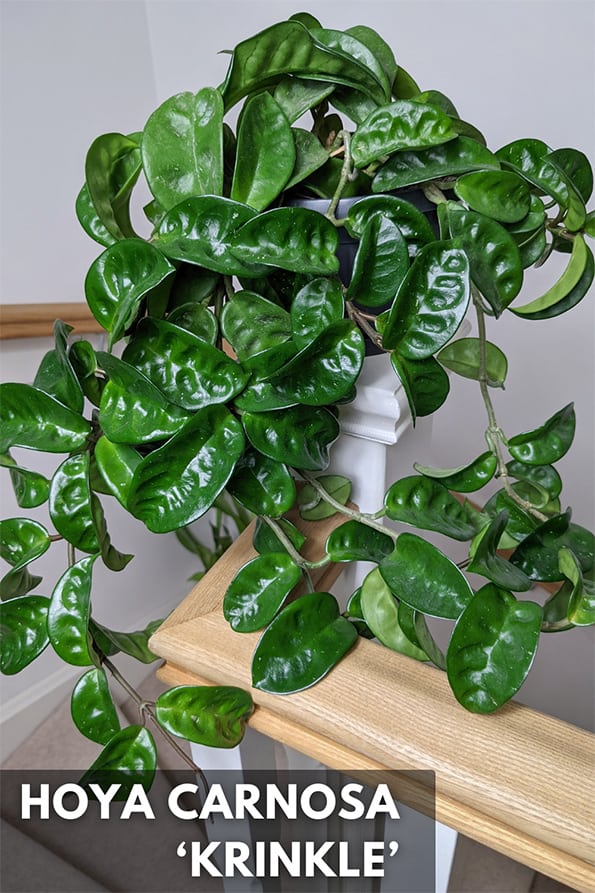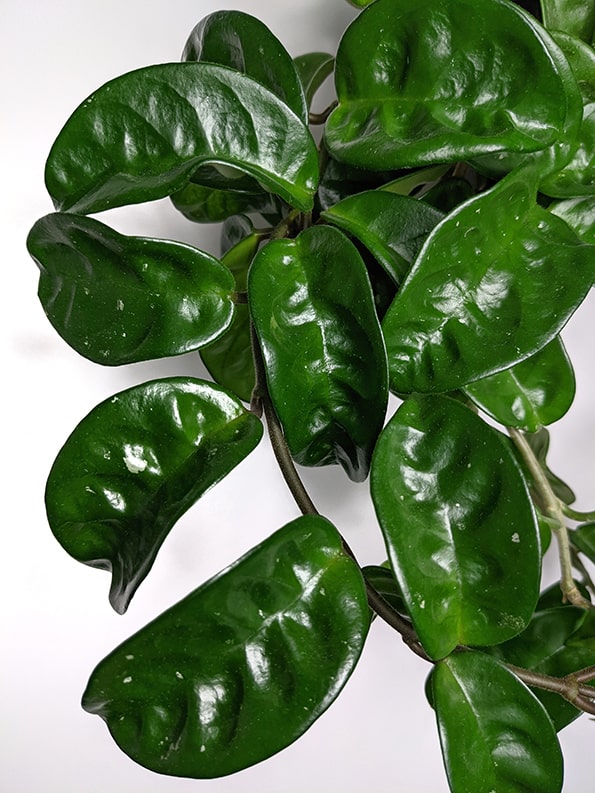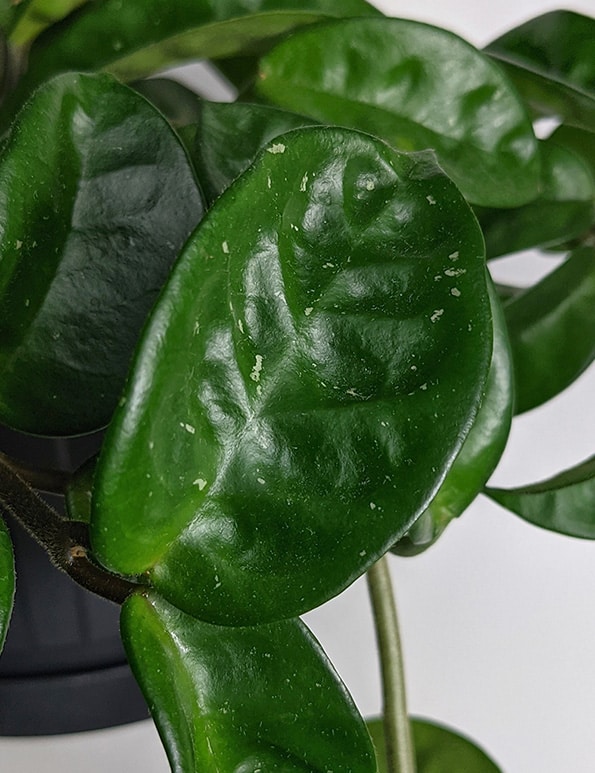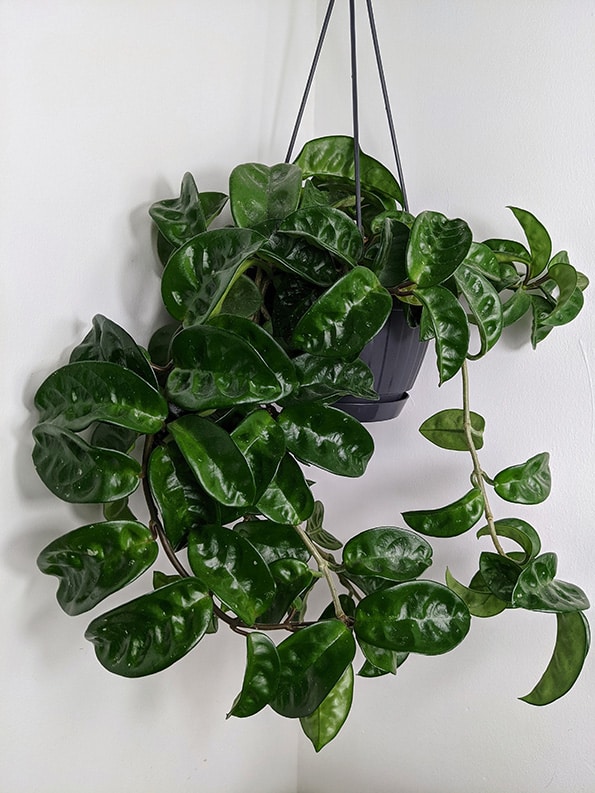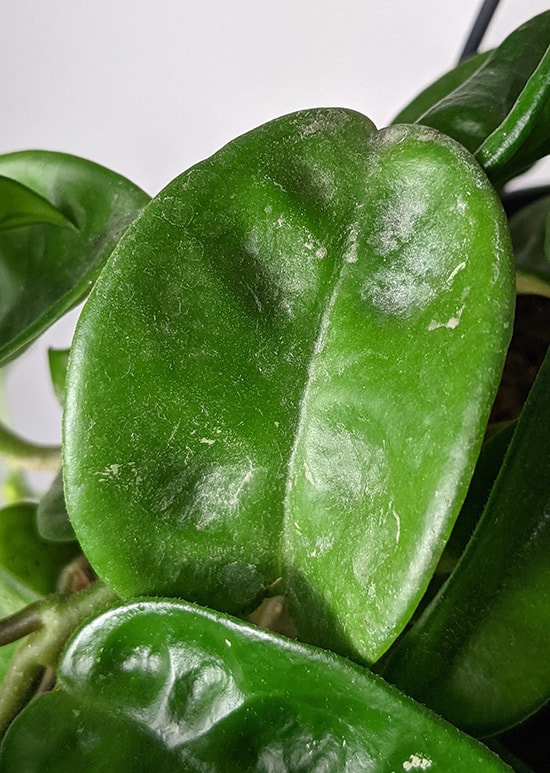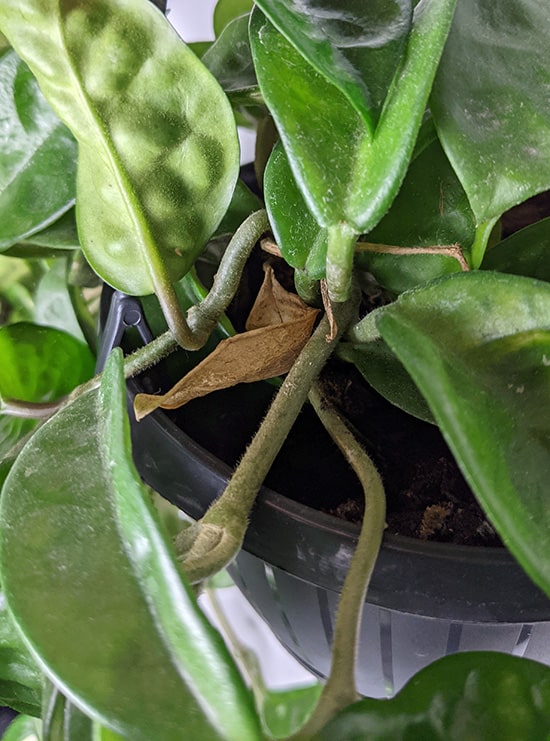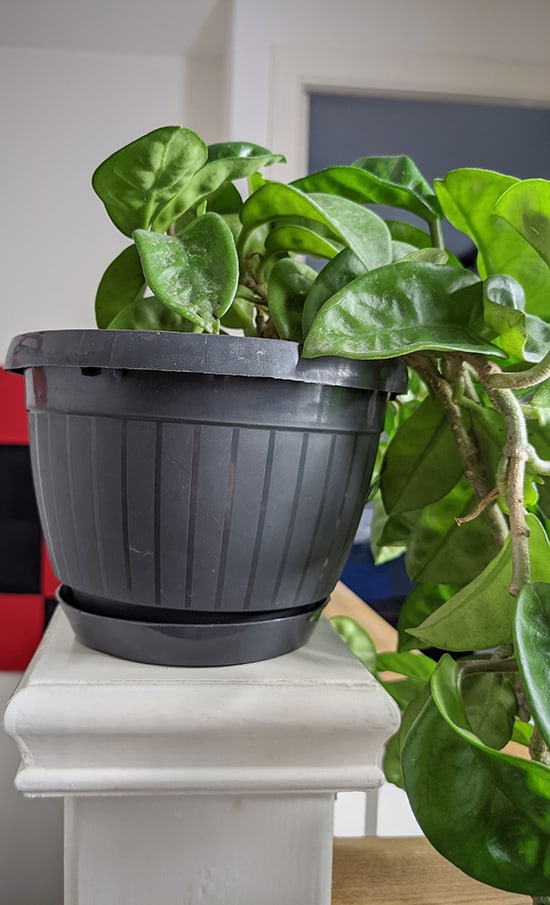Hoya Krinkle, also known as Hoya carnosa 'Krinkle 8', is a cultivar of the Hoya carnosa species.
It's an easy houseplant and tolerates a range of growing conditions. Fairly easy to grow indoors and long lived. They're trailing plants and look fantastic in hanging baskets or cascading down from a shelf or bookcase.
Its waxy leaves feature a unique, crinkled or wrinkled texture, hence the name "Krinkle".
I've had my plant for five years, and it's super low maintenance. Like other Hoya species, Hoya Krinkle will thrive in bright light (not too much sun though) and needs well-draining soil. With proper care, it will make a delightful addition to any indoor plant collection.
How do you pronounce Hoya Carnosa correctly? Say:
HOY-uh kar-NOE-suh.
Hoya carnosa Krinkle 8 is a cultivar that was created and patented in the 1960's. It was produced by crossing a Hoya carnosa (Wax Plant / Porcelain Flower) with a Hoya carnosa "Compacta" (Hindu Rope Plant).
Did You Know?
The original all-green Hoya carnosa was super popular in the 1970s but gradually lost popularity after the 1980s as it was considered "old fashioned.". Fortunately, Hoya is a genus of over 500 species from the Apocynaceae family and today many different looks and crosses are available. Many of these are grown as houseplants today, including the Krinkle 8.
The standard Carnosa plant has flat leaves and the Compacta has very curly and tightly folded leaves. The Krinkle is halfway between the two leaf shapes of its parents.
The "8" in the name comes from the number of dimples or depressions that occur in the upper surfaces of the mature leaves. They will usually number from six to ten on each leaf. Presumably the plant breeders went for "8" as it was in-between 6 and 10.
However, in most cases, people will just call it the Hoya Krinkle and so that's what I'm calling it for the rest of my guide.
The thick leaves are typically glossy and the dimples and slight curls in the leaf shape make for a visually attractive plant.
The Krinkle 8 is easy care and cheap to buy. The main issue you'll have is finding it.
Most shops only have limited selling space, and although the Krinkle has a great look, it has to compete with other more popular or eye-catching Hoyas. This makes it a limited plant or even uncommon. If you get stuck, you will find plenty of online plant stores or sellers who are selling it.
I assume if you're reading this you already own this plant and are looking for some plant care tips. So read on and I'll share what I've learned growing mine over the last five years.

Hi, I'm Tom!
If you're like me and enjoy the challenge of growing houseplants and getting them to thrive, then Ourhouseplants can help. This website shares my knowledge and years of growing plants and provides (hopefully) helpful advice on properly caring for your indoor plant friends.
Hoya carnosa Krinkle, like many other Hoya species, prefers bright, indirect light. They can take some full sun and some lower lit spots. But bear in mind that they can scorch in intense direct sunlight and in low light, growth is restricted or non existent.
So providing somewhere in the middle of those two extremes will give you the best long term results.
Artificial Light
If natural light is limited, you can supplement with artificial grow lights. Choose full-spectrum LED lights if you can (you can also use normal LED bulbs in a pinch) and position them a few feet above the plant to provide adequate light.
Light levels can also affect the Hoya Krinkle leaf color over a long period. Higher light levels will often cause a lighter green and plants growing in darker spots will often have darker leaves.
You can use that as a guide to work out if your plant is happy, but generally, if I'm getting new growth and the leaves look undamaged I'm not worried.
This is likely to be the biggest problem causer owners will come across. Getting the watering frequency and amount of water wrong, accounts for 90% of the reasons that people reach out to me for help.
Even though they have thicker fleshy succulent leaves compared to many other houseplants they don't like long periods of dryness. They're not true succulents. They do need to be watered.
On the flip side they're not aquatic plants either and don't need to be constantly moist. Let the roots breathe a little by letting the potting mix dry out.
Wait until at least half of the potting mix has dried before watering again. You could also wait until the potting mix has completely dried out (which is what I tend to do). But don't leave your plant like this for more than a day or two.
Many Hoyas, including the Krinkle 8, have leaf surfaces flecked with irregular small silvery spots. But these flecks won't appear on every single leaf. This is normal and just something the plant does (or doesn't do).
The frequency of watering will depend on your environmental factors. It will take far longer for the potting mix to dry out over Winter when temperatures are cooler and there is less light.
When it's warm and there is more light around, your plant will dry out faster and will need more frequent watering.
Most Hoya species love higher humidity. But I find the Carnosa species (and its cultivars) are less fussy about it. If you can provide higher levels of humidity then do so, but if you can't don't worry too much.
My home humidity is variable throughout the year, sometimes it's almost 70% and at points its closer to 40%. But if you look at the photos in this article you won't spot a single brown leaf edge. Not one.
Although lower humidity levels are unlikely to damage the appearance of your plant, it can slow or stop the growth of Hoyas.
They come from a subtropical climate, however the humidity does still vary through the year. The dormant period for plants in their native habitat will often occur over their winter time which is also when humidity levels drop. But if that lower level is happening in your home, then it could trigger dormancy even if it's not Winter.
However, they're typically very long lived plants and if growth pauses for a few months a year, I'm honestly not seeing that as a problem. If speed and constant growth is something you're looking for (and not getting), then boosting humidity around your Hoya could be something to think about.
I find the Hoya Krinkle is an average feeder. It's not up there with the seriously hungry plants, but it still needs feeding occasionally. These plants also produce some very nice looking blooms and can do this several times a year. This all needs to be fueled.
A balanced, water-soluble fertilizer with a formulation such as 10-10-10 or 20-20-20 is the way to go. These numbers mean the fertilizer contains equal parts nitrogen (N), phosphorus (P), and potassium (K), providing essential nutrients for plant growth.
Winter Feeding
Some people will have indoor conditions that allow their Hoya to grow, even over Winter. If you can see growth then feed as normal. For everyone else, stop doing it towards the end of Summer and resume the following Spring.
You don't have to look for this perfectly balanced mixture, but if you're presented with several and this is an option on the shelf go for it. Any feed that mixes all three NPK nutrients will aid your plant's growth and health.
Dilute it to quarter strength and you can feed your plant every couple of waterings. If that's too much hassle aim for half strength and feed monthly. Too much fertilizer can cause leaf burn and damage the roots.
Average or warm temperatures are what this plant is looking for. You'll get growth from around 17°C (62°F) and above. They're not fans of cold temperatures so try not to let it dip below 10°C (50°F) at any point.
The great news here is that Hoya Krinkle doesn't need frequent repotting. They're actually epiphytic plants, so the root system is comparatively smaller than other houseplants.
Some plants will stop growing if the planter is too small though. The roots do need some space. They'll also benefit from a fresh potting mix every few years. The old stuff will eventually break down and struggle to hold nutrients and water.
Aim to repot once every two or three years. They won't need giant sized containers. Just a little bigger than the previous one will be ideal.
Your Hoya Krinkle will struggle in dense potting mixes that stay wet for long periods. They need fast draining soil. For that reason, 100% peat moss compost should be avoided.
Peat free mixes often provide a good balance between water retention and large materials that keep things open. This makes it free draining and supports aeration for the roots. All things Hoyas love.
If this isn't something you can't buy, a normal potting mix is fine if you can mix in the larger materials. For example adding orchid bark, perlite or grit will all work to create good drainage for the mix.
Hoya Krinkle propagation is pretty straightforward. I've done it before but didn't take photos (doh!). I'll probably do it again and put it into a YouTube video at some point (feel free to subscribe to my channel by the way!).
However here is what I did.
Select a healthy stem with at least one node (where the leaves emerge).
Using clean, sharp scissors or pruners, cut a 4-6 inch section of the stem just below a leaf node. The stem is important for the propagation attempt. If you run your fingers generally over one you'll feel little hard nubs. These are adventitious roots and once in a potting medium like soil, or water, they will grow into the proper roots needed for a healthy plant.
Top Tip
When you take the cuttings, a white latex sap is likely to leak out a little. Running it under a cold tap for 20 seconds should stop it.
Remove any leaves from the lower portion of the cutting that will be submerged in the rooting medium.
Allow the cut end to callus over for a day to reduce the risk of rot. Plant the cutting in a well-draining potting mix or place it in water until roots develop.
Once the cuttings have rooted and established themselves, you can treat them like mature Hoya plants and continue to care for them accordingly. Remember to be patient, as Hoya plants can take some time to develop roots and new growth.
The Hoya Krinkle has sporadic growth. It can seem dormant for months at a time, then you'll notice a quick succession of new leaves. So it can be fast or slow. It depends!
Compared to other houseplants over a long period, I would class this as a slightly below average grower.
In optimal conditions, Hoya carnosa can grow up to several feet in length or width. However, the growth rate and ultimate size can be influenced by several factors.
For example using smaller planters will restrict growth. The stems can be a little unruly so people often prune them into shape to keep them neat and tidy.
They can be grown in normal planters and containers, but I think they look their best in a hanging pot or basket like this.
The Hoya Carnosa species including the Krinkle will produce wonderful star-shaped flowers in clusters.
Typically a single peduncle will appear (although larger and very mature plants can produce more) and at the end of this many flower clusters will form.
They will eventually open and you'll have a large ball shape held above the plant. It looks very intricate and beautiful. The star-shaped flowers can be pink or white and will last several weeks.
Did you know?
After flowering, the small stems that are holding the actual flowers will fall off the plant. The peduncle itself will often stay in place. Don't remove it and it's possible another set of flowers will form a few months later.
Plants don't always flower. Here are a few conditions that generally have to be met (or will encourage) flowering.
The leaves and the stems do contain a sticky white sap. This has either no toxicity (or very low amounts). So, although the material may be irritating the ASPCA list it as pet friendly.
Dusty and dirty leaves.
The Hoya Krinkle has thick and stiff leaves with an unusual shape. It's easy for dust to settle on them over time.
A quick wash in a shower should help clean things up. You can also use a damp cloth.
The waxy thick green leaves have small depressions that can easily trap dust. A good wash or damp cloth will sort this out.
Yellow or Brown Leaves.
If you have one or two leaves going brown and no other symptoms, I would tell you it's likely to be natural aging and nothing to be concerned about. Lots of leaves going yellow or brown is a problem.
Even with quite basic care routines, brown or yellowing leaves are quite an unusual thing to see.
So what does it mean if you have lots of leaves going yellow and brown? Let's do some troubleshooting.
Leaf Drop.
Even if you only provide basic care, Hoya Carnosa Krinkle doesn't drop its leaves easily. After years of ownership I think I've lost perhaps... 5 leaves.
If the leaves are falling they're likely going brown or yellow first. This is going to be for the same reason(s) discussed in the above problem.
No Growth.
They tend not to grow all year round so some dormant periods are normal. But there can be other causes for lack of growth.
No Flowers.
Check out my flower section in the care guide above for some pointers to help get your Hoya Krinkle flowering.
Pests.
Generally, Hoya plants are slightly resistant to pests and seem to cope okay even when you spot them. But they're not beneficial to your plant and should be removed.
Aphids, mealybugs, and scale insects could all be found in among the leaves. Treat infestations with insecticidal soap or neem oil.
Lopsided Growth
Hoya are primarily trailing plants, they don't grow into neat bushes. So it's very normal for the stems to trail in one direction and have a prominent "face". Typically, they'll grow in the direction of the light source.
Hoya Krinkle is often treated as a trailing plant, so make sure you have some space for the stems to hang downwards.
You could try and trail your Krinkle plant up a trellis, which will give you some control over it's look. Personally, I go with whatever my plants want. Putting it into a location where the side and back are hidden from view. It's just easier.
Faded Washed Out leaves.
Multiple things can cause this to happen.
